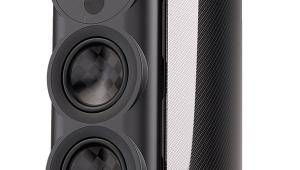Quad ESL [ESL 57] (Vintage)
In 1955 Wireless World published articles by Quad’s Peter Walker on the practical and theoretical aspects of making a full range electrostatic speaker. That year, he demonstrated two different prototypes developing one for the first public demonstration at the 1956 Audio Fair. Due credit must be given to Walker for the huge amount of pioneering work involved and the brave decision to make it a commercial product.
When first introduced, a single ESL would have set you back £52, yet demand was far greater than supply. The speaker (later dubbed the ESL-57) weighed in at around 16kg and measured 800x875x267mm (hwd). Frequency response was a claimed 45Hz- 18kHz while dispersion was said to be approximately 70° in the horizontal plane and 15° in the vertical. Mains consumption was given at 6W.
As constructed, the ELS was a doublet source, the diaphragm radiating from both faces (at least at LF). Frequency response curves in free air conditions show the it to have a figure-of-eight polar characteristic at low frequencies and cardioid at high frequencies.
Quad recommended that the speaker should not be positioned closer than 2ft to any parallel wall or 3ft from any corner. Stacked pairs brought gains in bass extension and soundstaging. The late Alastair Robertson-Aikman, MD of SME, had these in his legendary music room.
In the 1960s, the Braun LE1 was made under licence from Quad in Germany. Several different dedicated stands and subwoofers have been marketed over the years with promises to enhance sound quality. Between 1957 and 1985, no fewer than 54,000 ESLs were sold worldwide.
IN THE HOT SPOT
While delightful and satisfying off-axis, the ESL really does defi ne ‘hot seat’ in all its restrictive glory. A stereo pair will fi ll a room, but the ideal spot for stereo is a narrow slice at the point of an almost-equilateral triangle. There are concerns too that prevent the ESL from being a viable speaker for those used to the robustness of recent designs.
They don’t go loud enough or deep enough for modern tastes, and they’re fragile both physically and in terms of voltage input. Still, if you can live with the need for mains charging, positioning away from the walls and bass extension that may seem ‘quaint’, rewards are seamlessness, coherence, neutrality, transparency and scale that many speakers may emulate, but not offer all in the same package. You get an LS3/5A’s imaging and midband, the imaging of a Wilson, an Apogee’s top-tobottom consistency and the silkiness of a Sonus faber.
VERDICT
The ESL can still thrill with a sound that’s open, airy, effortless and to many ears so downright addictive that good clean examples are highly sought after. Chances are that at some point servicing or repair will be required, and the costs now are not for the fainthearted.
Originally published in the Yearbook 2010

















































